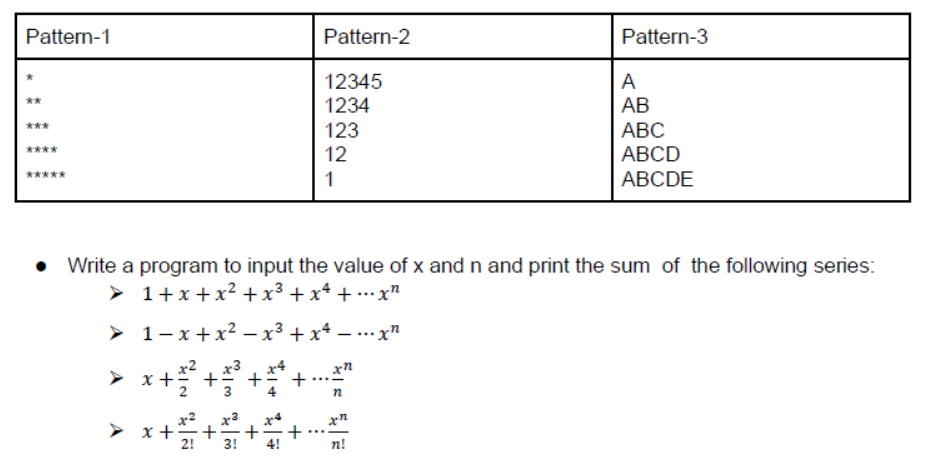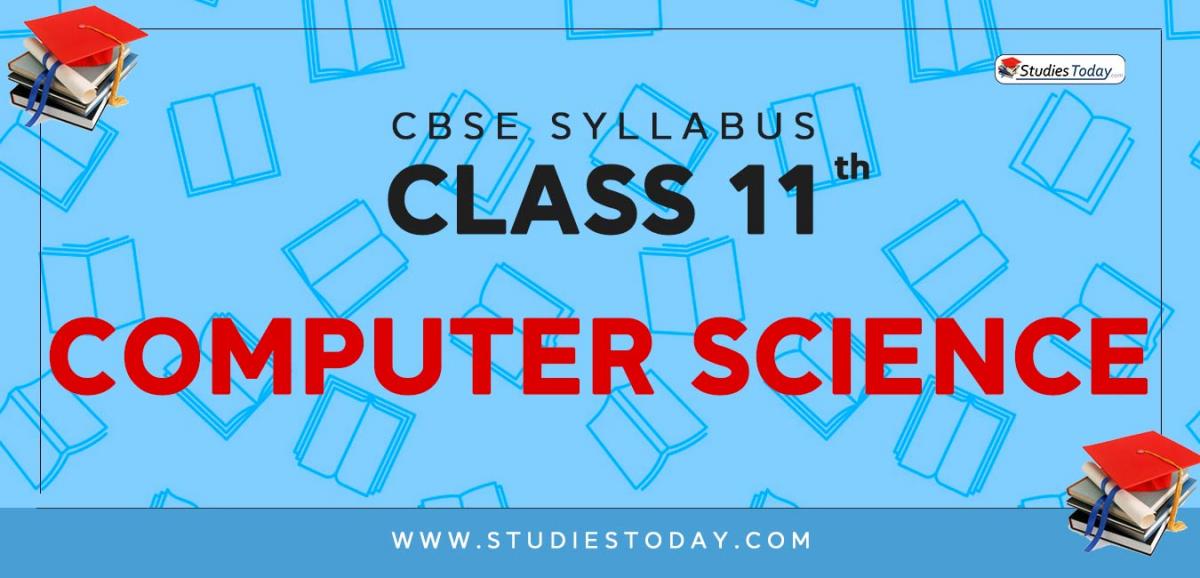Download CBSE Class 11 Syllabus for Computer Science 2023 2024. Refer to the latest syllabus provided below and free download latest curriculum of Class 11 for Computer Science issued by CBSE and NCERT, free download in pdf, get topic wise weightage, suggested readings and books based on latest syllabus and guidelines. The Computer Science Class 11 Syllabus curriculum has been developed and issued by CBSE and NCERT for Computer Science in Class 11. All students studying in Class 11 are suggested to go through latest syllabus to ensure that their preparation is as per the latest syllabus issued by CBSE NCERT KVS. Class 11 Computer Science students should do preparation for Computer Science exam strictly based on the latest curriculum and concentrate more on the topics with higher weightage to help them score higher marks in Class 11 Computer Science class tests and exams
Class 11 Computer Science Syllabus
It is important for students to study as per the latest Class 11 Computer Science curriculum and marks breakup as per important topics. This will help to prepare properly for the upcoming examination. You can click on the following links to download the latest and past year syllabus provided by us below.
Year Wise Computer Science Syllabus Class 11
Computer Science
Class -XI
Code No. 083
2023-24
1. Learning Outcomes
Students should be able to:
a) develop basic computational thinking
b) explain and use data types
c) appreciate the notion of algorithms
d) develop a basic understanding of computer systems- architecture, operating system, and cloud computing
e) explain cyber ethics, cyber safety, and cybercrime
f) understand the value of technology in societies along with consideration of gender and disability issues.
2. Distribution of Marks
Unit Unit Name Marks Periods
No. Theory Practical
I Computer Systems and Organisation 10 10 10
II Computational Thinking and Programming -1 45 80 60
III Society, Law, and Ethics 15 20 —
Total 70 110 70
3. Unit wise Syllabus
Unit I: Computer Systems and Organisation
● Basic computer organisation: Introduction to Computer System, hardware, software, input device, output device, CPU, memory (primary, cache and secondary), units of memory ( bit, byte, KB, MB, GB, TB, PB)
● Types of software: System software ( Operating systems, system utilities, device drivers), programming tools and language translators ( assembler, compiler, and interpreter), application software
● Operating System(OS): functions of the operating system, OS user interface
● Boolean logic: NOT, AND, OR, NAND, NOR, XOR, NOT, truth tables and De Morgan’s laws, Logic circuits
● Number System: Binary, Octal, Decimal and Hexadecimal number system; conversion between number systems
● Encoding Schemes: ASCII, ISCII, and Unicode (UTF8, UTF32)
Unit II: Computational Thinking and Programming - I
● Introduction to Problem-solving: Steps for Problem-solving (Analyzing the problem, developing an algorithm, coding, testing, and debugging), representation of algorithms using flowchart and pseudocode, decomposition
● Familiarization with the basics of Python programming: Introduction to Python, Features of Python, executing a simple “hello world" program, execution modes: interactive mode and script mode, Python character set, Python tokens( keyword, identifier, literal, operator, punctuator), variables, concept of l-value and r-value, use of comments
● Knowledge of data types: Number(integer, floating point,complex), boolean, sequence(string, list, tuple), None, Mapping(dictionary), mutable and immutable data types.
● Operators: arithmetic operators, relational operators, logical operators, assignment operators, augmented assignment operators, identity operators (is, is not), membership operators (in not in)
● Expressions, statement, type conversion, and input/output: precedence of operators, expression, evaluation of an expression, type-conversion (explicit and implicit conversion), accepting data as input from the console and displaying output.
● Errors- syntax errors, logical errors, and run-time errors
● Flow of Control: introduction, use of indentation, sequential flow, conditional and iterative flow
● Conditional statements: if, if-else, if-elif-else, flowcharts, simple programs: e.g.: absolute value, sort 3 numbers and divisibility of a number.
● Iterative Statement: for loop, range(), while loop, flowcharts, break and continue statements, nested loops, suggested programs: generating pattern, summation of series, finding the factorial of a positive number, etc.
● Strings: introduction, string operations (concatenation, repetition, membership and slicing), traversing a string using loops, built-in functions/methods–len(), capitalize(), title(), lower(), upper(), count(), find(), index(), endswith(), startswith(), isalnum(), isalpha(), isdigit(), islower(), isupper(), isspace(),lstrip(), rstrip(), strip(), replace(), join(), partition(), split()
● Lists: introduction, indexing, list operations (concatenation, repetition, membership and slicing), traversing a list using loops, built-in functions/methods–len(), list(), append(), extend(), insert(), count(), index(), remove(), pop(), reverse(), sort(), sorted(), min(), max(), sum(); nested lists, suggested programs: finding the maximum, minimum, mean of numeric values stored in a list; linear search on list of numbers and counting the frequency of elements in a list.
● Tuples: introduction, indexing, tuple operations (concatenation, repetition, membership and slicing); built-in functions/methods – len(), tuple(), count(), index(), sorted(), min(), max(), sum(); tuple assignment, nested tuple; suggested programs: finding the minimum, maximum, mean of values stored in a tuple; linear search on a tuple of numbers, counting the frequency of elements in a tuple.
● Dictionary: introduction, accessing items in a dictionary using keys, mutability of a dictionary (adding a new term, modifying an existing item), traversing a dictionary, built-in functions/methods – len(), dict(), keys(), values(), items(), get(), update(), del(), del, clear(), fromkeys(), copy(), pop(), popitem(), setdefault(), max(), min(), sorted(); Suggested programs: count the number of times a character appears in a given string using a dictionary, create a dictionary with names of employees, their salary and access them.
● Introduction to Python modules: Importing module using ‘import <module>’ and using from statement, importing math module (pi, e, sqrt(), ceil(), floor(), pow(), fabs(), sin(), cos(), tan()); random module (random(), randint(), randrange()), statistics module (mean(), median(), mode()).
Unit III: Society, Law and Ethics
● Digital Footprints
● Digital Society and Netizen: net etiquettes, communication etiquettes, social media étiquettes
● Data Protection: Intellectual property rights (copyright, patent , trademark), violation of IPR(plagiarism, copyright infringement, trademark infringement), open source software and licensing (Creative Commons, GPL and Apache)
● Cyber Crime: definition, hacking, eavesdropping, phishing and fraud emails, ransomware, cyber trolls, cyber bullying
● Cyber safety: safely browsing the web, identity protection, confidentiality
● Malware: viruses, trojans, adware
● E-waste management: proper disposal of used electronic gadgets.
● Information Technology Act (IT Act)
● Technology and society: Gender and disability issues while teaching and using computers
4. Practical
S.No. Unit Name Marks (Total=30)
1. Lab Test (12 marks) 12
Python program (60% logic + 20% documentation
+ 20% code quality)
2. Report File + Viva (10 marks)
Report file: Minimum 20 Python programs 7
Viva voce 3
3. Project (that uses most of the concepts that have been learnt) 8
5. Suggested Practical List
Python Programming
● Input a welcome message and display it.
● Input two numbers and display the larger / smaller number.
● Input three numbers and display the largest / smallest number.
● Generate the following patterns using nested loops:

● Determine whether a number is a perfect number, an Armstrong number or a palindrome.
● Input a number and check if the number is a prime or composite number.
● Display the terms of a Fibonacci series.
● Compute the greatest common divisor and least common multiple of two integers.
● Count and display the number of vowels, consonants, uppercase, lowercase characters in string.
● Input a string and determine whether it is a palindrome or not; convert the case of characters in a string.
● Find the largest/smallest number in a list/tuple
● Input a list of numbers and swap elements at the even location with the elements at the odd location.
● Input a list/tuple of elements, search for a given element in the list/tuple.
● Create a dictionary with the roll number, name and marks of n students in a class and display the names of students who have marks above 75.
6. Suggested Reading Material
● NCERT Textbook for Computer Science (Class XI)
● Support Material on CBSE website
You can download the CBSE 2025 Syllabus for Class 11 Computer Science for latest session from StudiesToday.com
Yes, you can click on the links above and download Syllabus in PDF for Class 11 for Computer Science
Yes, the syllabus issued for Class 11 Computer Science have been made available here for latest 2025 academic session
You can easily access the links above and download the Class 11 Syllabus Computer Science
There is no charge for the Syllabus for Class 11 CBSE Computer Science you can download everything free
Planning your studies as per syllabus given on studiestoday for Class 11 subject Computer Science can help you to score better marks in exams
Yes, studiestoday.com provides all latest CBSE Class 11 Computer Science Syllabus with suggested books for current academic session
Yes, studiestoday provides curriculum in Pdf for Class 11 Computer Science in mobile-friendly format and can be accessed on smartphones and tablets.
Yes, syllabus for Class 11 Computer Science is available in multiple languages, including English, Hindi


